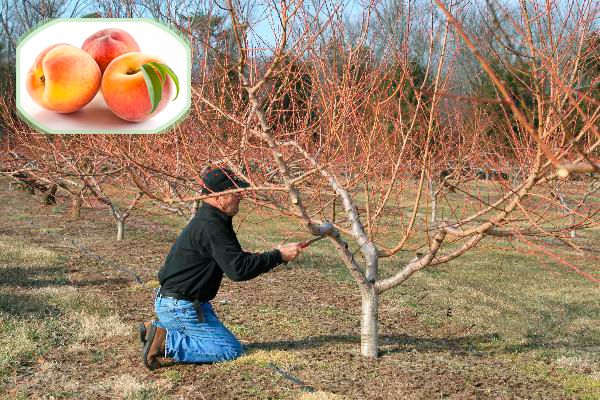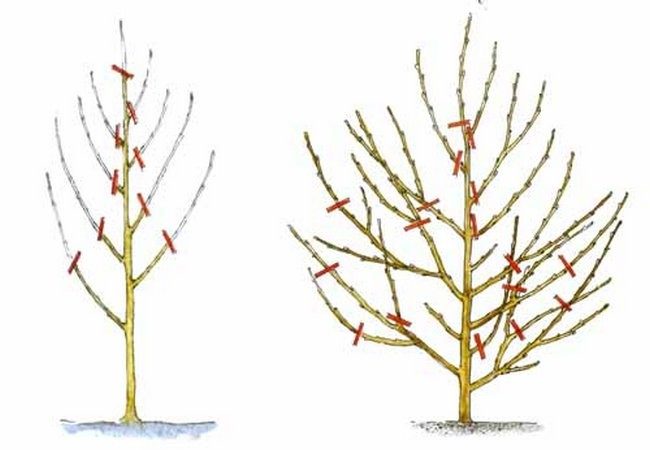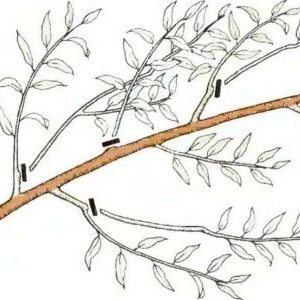How to properly prune a peach in the fall and what is it for
It takes a lot of work to get a good harvest of peaches - this is a very capricious crop. Crown pruning is one of the important procedures for caring for this plant. Read about why peach pruning is carried out in the fall and how to do it correctly in the article.
The content of the article
Why cut a peach in the fall, what does it give
Any plant, including the peach tree, gets its nutrients from the soil... They pass through the trunk and are distributed along the branches. The peculiarity of the peach is that this process takes place faster in it than in other plants.
If pruning is ignored, the crown will become too thick and the branches in the center will no longer receive enough sunlight and nutrients.
Important! Pruning increases the yield of the plant and prolongs its life.
If you do not carry out this procedure, the tree will look sloppy, the branches will grow chaotically, and it will be much more difficult to harvest from such a tree.
Optimal timing of the procedure

Pruning is stressful for every plant... Pruning in the spring will cause a significant drop in yields this season. But even at this time it has its meaning: it is aimed at forming the correct crown of the tree, which will provide access to sunlight to all branches and facilitate the gardener in the future harvesting.
Fall pruning is considered safer. The vegetative processes of the plant are significantly slowed down - it prepares for the cold, so the tree will more easily tolerate injury. In the autumn, shortening and reducing the number of fruiting branches are carried out. The main task of autumn pruning is to prepare the plant for wintering.
Reference. The optimal time for autumn pruning is after harvest and until October 15th. Spring pruning is carried out from mid-March to April 20.
Types of trimming
Depending on the purpose, several types of trimming are distinguished.
Shaping is aimed at giving the crown of the tree the correct shape.
Rejuvenating is carried out in the autumn, it involves the cleaning of old branches that compete with the young for nutrients.
Sanitation involves cleaning dry, lifeless branches in order to protect the plant from fungus and pests.
How to prune a peach correctly
Subject to the rules for conducting and using high-quality equipment, pruning is an absolutely safe procedure for a peach.

Required materials and tools
To carry out pruning, you will need a pruner, a garden saw, a delimber, and a garden knife.
Important! All tools must be well sharpened, immediately before work they are treated with an antiseptic.
Trimming scheme
Pruning is performed annually according to the following scheme.
1 year
Reduce the height of the annual seedling to 50 cm. The rest of the tree should have 2 large branches or developed buds. They are tied to thin slats so that they are at a 45 ° angle to the trunk. From the rest of the lateral branches, one upper bud is cut off.
2 years
It is considered ideal if these lateral shoots grow 50 cm the next year. If this does not happen, then the central shoot is cut to the place where these branches depart from the main trunk.
If the length of the branches is less than 40 cm, then they are cut to the last growth or triple bud, which is as far as possible from the trunk. On these branches, 2 developed shoots are selected and tied to the same rail. The remaining shoots are cut to the leaf closest to the main shoot.
3 years
The next fall, all large branches are shortened by about a third. Then, 3 shoots are selected on them and all growth buds directed downward are removed. These branches are tied to the rail, and the rest are cut to the first leaf.
4 years
If the pruning was carried out correctly, the tree pleases the gardener with a good harvest in the fourth year. Often peaches are planted near the walls. All shoots directed perpendicular to the wall are removed, with the exception of those on which flowers appear in the fall - at least 2 leaves are left on them.
Step-by-step instructions for pruning

Pruning involves several steps:
- Sanitary treatment. All shoots and branches that have defects and damage are removed.
- Shortening shoots. All shoots of the tree are pruned - those that make up the frame and those that bear fruit.
- Pruning vulnerable branches. The structure of the tree is assessed and fragile and vulnerable branches are completely removed.
Tree formation
It is recommended to strive for the formation of a peach crown in the form of a bush - this is due to the peculiarities of the movement of nutrients along the tree. In addition, this shape contributes to an even distribution of sunlight over all branches.
Optimal tree parameters:
- lower tier - 20 cm;
- stem - 50-60 cm;
- between the bases - 3-4 skeletal branches;
- on each branch - 2 semi-skeletal branches of the second order at a distance of at least 30 cm from each other;
- above the first tier - the second tier of semi-skeletal branches, up to 5 pcs.
Features of pruning young and old trees
The procedure has its own characteristics for trees of different ages.
Young tree
All manipulations are done carefully. Excessive branch removal can kill the plant.
Rules:
- the main shoot is pinched in the event that there are young shoots on the seedlings;
- when planting a tree, only 3-4 shoots are left, directed downward, all the rest are removed;
- the branches located in the center are pruned in the third year as short as possible.
Old tree
The peculiarities of pruning an old peach depend on how carefully the owner looked after it. If not enough attention has been paid to the tree, you will have to remove not only small, but also large branches, and sometimes even parts of the tree. However, even an old tree can be brought back to life by pruning.
Slicing processing and further care
Since the procedure is very traumatic, they pay attention to the correct pruning technique and provide the tree with further care.
The places of the cuts are treated with garden pitch so that the infection does not get there and they heal faster. The sections are processed one day after the procedure.
Further care is to ensure regular hydration, feeding and prevention of parasite infestations.
After the autumn pruning, winter watering is carried out: it increases the winter hardiness of the tree. Water consumption: 90-100 liters per 1 m² of trunk circle.
Peach care includes the introduction of fertilizers into the soil, the quality and composition of which depends on the characteristics of the soil. Fertilizers are applied to poor soil every year, and it is enough to fertilize fertile soil once every 2-3 years. In autumn, 40 g of superphosphate and 50 g of calcium chloride per 1 m² are added to the soil. Once every 2-3 years, the plant is fed with organic fertilizers: humus or compost.
In order to prevent the fight against parasites (aphids, fruit moths, moths) and fungi, the peach tree is treated with 7% urea solution or 1% copper sulfate solution before wintering.
The nuances of pruning by region
The features of pruning depend on the regions in which the plant is grown.
Crimea, Kuban
In the warmest regions, early varieties of peaches are common. They are pruned in March. The crown is cupped, providing uniform illumination of all branches. Fruit branches are shortened, stimulating the emergence of new shoots.
Middle zone of Russia
In regions with a temperate climate, the procedure is carried out in late March - early April. Form in the form of a bush with developed lower shoots, which are removed after fruiting.
Northern regions
In cold climates, the seedlings are planted at a 45 ° angle. A bole is created with two large branches bearing fruit alternately, covered for the winter. Everything else is cut off.
It is interesting:
A beginner's guide: how to care for a potted pomegranate at home.
Step-by-step guide to propagating pomegranate cuttings at home.
Conclusion
Pruning a peach tree is a must for a plant. Depending on the purpose, it can be of different types: sanitary, rejuvenating, forming the crown of a tree. Correctly performed procedure increases the yield and lifespan of the peach.